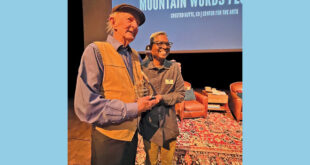By Dawne Belloise
In the original 1960s Star Trek series, the episode titled “Mudd’s Women” had a magic pill, the fabled Venus drug, that enabled women of ordinary, if not haggardly, appearance to super-enhance their looks into stunning beauty, making them irresistible to all men (except Spock, of course) so they could be bartered as brides for lonely and rich men in far-flung corners of the galaxy.
When Captain Kirk discovers the scam, he switches the Venus pill with a placebo but the alluring changes still occur in one of the unsuspecting women. In his notorious swagger, he proves that it’s actually their self-confidence that makes them attractive (they marry their intended marks and all is well).
But the real question is, what does make potential lovers and mates attracted to each other?
From the perspective of evolutionary biology, attraction, along with its consequences of love, is a complex neurobiological phenomenon, hardwired by the forces of evolution from prehistoric times when having both parents stay together to give their offspring better odds of survival gave our species the jump we needed.
Apparently, it worked well because humankind has come a long way, in population at least, from caves into the bars, lift lines and parties of modern-day courting antics. Because we’re a mountain town and ski resort, we follow a different set of rules, if any, in determining what is attractive in a potential lover or even long-term mate. Oftentimes, we don’t even understand what it is that makes that someone so appealing. Sometimes it’s the heat of the night, or cold of the evening, the tall drinks and that last PBR that speaks, and consequently the alcohol influence is too late discovered when that Walk of Shame is initiated in the wee hours of morning reality. Loneliness, reality enhancements and the need to double up on cold winter nights are probably some of the biggest motivators and most powerful aphrodisiacs responsible for hookups up here at elevation.
An aphrodisiac, by definition, is a food, drink or drug that stimulates sexual desire and inspires lust, or a thing that causes excitement. The Romans worshipped the apple as an aphrodisiac. Music can be a strong aphrodisiac. There are herbs and foods known to have peculiar effects on both men and women, and there have been purported love potions throughout time.
Why they’re called aphrodisiacs is confusing since the word is derived from the ancient Greek mythological goddess, Aphrodite, who is born of the severed testicles of the ambushed god Uranus after Cronus, his son, hacks them off with a sickle and tosses them out to sea. Aphrodite is then created from the white sea foam produced by the barbaric action, arrives on a half shell upon the crest of a wave, making oysters one of the oldest aphrodisiacs known to man.
Legend supposes that Casanova ate more than 50 raw oysters every morning to boost his libido, and did so in a bathtub with the woman he was romancing. In the 17th century, bean soup was banned from the Convent of St. Jerome because of its purported erotic qualities. To ancient Romans, the bean’s flower represented sexual pleasure. Pomegranates are considered not only sexually suggestive but are also associated with fertility. Studies have actually shown that many foods possess chemical components that elevate mood, and even create the sensation of falling in love.
So, as for aphrodisiacs—we’re not talking drugs here, although a bowl of the legal green might enhance mutual attraction—evoking interest can take many forms and is entirely different for varying couples. Taste, smell and touch are forceful elements in desirability. Nature created pheromones for a good reason. As one local pub patron smirked, “The smell of the upstairs bathroom of the Talk of the Town at 4 a.m.—works every time,” while one unassuming man only required “a pulse.” Another Buttian noted, “I staked my life on laughter but since I’m still single, it may be time for a change of plans.”
Clearly, it’s not any one particular trait or essence but a combination of elements that will also extend one-nighters into successful long-term relationships, as one woman said: “Kindness and patchouli gets me every time.” Yet another happily married woman said, “Outdoor adventures, like skiing and bagging peaks. Doing things that get the adrenaline pumping and that also require trust in your partner.” One poetic man preferred, “that unmistakable sideways glance that’s an invitation to dancing in the stars,” and in finding true love, all one mountain girl needed was “a powder day and a happy, joyful man with a huge smile.”
The effect of mood, suggestion and anticipation coupled with sharing and desire, more than even medicinal magic, is the true aphrodisiac—the implication that there are more enjoyable things you could be doing alone together, with doors that lock and no children around. When all is said and done, perhaps the most convincing stimulant is the magic of that first kiss and in actuality, it’s a bio-chemical reaction, a taste of compatible pheromones and it determines more about you to a potential partner than you may have realized.
When people pick up each other’s pheromones during a wet kiss, they’ll subconsciously become either more or less sexually attracted to each other depending on what they sense. It’s theoretically believed that kissing bonds couples through the release of oxytocin, a hormone that floods the brain with love and trust when lips touch (real chocolate also simulates this feeling…).
So, whether you’re looking for temporary romance or everlasting love, take your partner out for a succulent dinner, a little bit of libation, gaze into each other’s eyes and kiss long and deeply. Make every day Valentine’s Day.
 The Crested Butte News Serving the Gunnison Valley since 1999
The Crested Butte News Serving the Gunnison Valley since 1999




